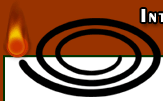Glossary of Terms
[
A] [
B] [
C] [
D] [
E] [
F] [
G] [
H] [
I] [
J] [
K] [
L] [
M] [
N] [
O] [
P] [
Q] [
R] [
S] [
T] [
U] [
V] [
W] [
X] [
Y] [
Z]
k-values
k-values (K = log N - log S) Subscripts (eg. k1, k2, ... kn) refer to successive stages at which the moralities act.
K
Generation mortality expressed as a k-value.
K
Carrying capacity. The equilibrium population density from the logistic equation.
K
D Soil/water partition coefficient; the ratio at equilibrium of the concentrations of chemicals in soil and water. Units of mlg1.
Kairomone
A chemical or mixture of chemicals emitted by an organism (e.g. a plant) that induces a response in an individual of another species (e.g. an insect) that is beneficial to the receiving organism. An example of a kairomone is a plant scent that makes the plant more easily identifiable to an insect pest. (See also allomone)
Kala-azar
Disease caused by Leishmania donovani; also called Dumdum fever or visceral leishmaniasis.
Kaolin
A white clay derived from rock composed chiefly of feldspar. The main chemical constituent is hydrous aluminium silicate.
Katabatic wind
Any wind blowing down an incline, often due to cold air drainage.
Karyogamy
Caryogamay. A union of nuclear material.
Ked
Louse fly of the family Hippoboscidae.
Keel
Ridge resembling a boat's keel, as in the glumes of certain grasses. The inferior petal in the flowers of legumes.
Kentrogon
Larva in the crustacean order Rhizocephala that is attached to its host crab; formed after the cypris larva moults and its appendages and carapace are discarded.
Keratitis
Inflammation of the cornea.
Kerato-conjunctivitis
Inflammation of cornea and conjunctiva.
Kernel
Whole grain of a cereal; the mature ovule.
Kernel weight 1,000 (1,000 grain weight)
A crop yield or crop loss parameter.
Key factor
see limiting factor.
Key pests
An important major pest species in the complex of pests attacking a crop that dominate control practices and that in the absence of human intervention commonly attain population densities that exceed economic injury levels.
Kinetid
Axoneme of a cilium of flagellum together with its basal fibrils and organelles. Also called a mastigont.
Kinetodesmose
Compound fibre joining cilia into rows.
Kinetoplast
Conspicuous part of a mitochondrion in a trypanosome from which the flagellum arises.
Kinetosome
Centriole from which an axoneme arises; also called a basal body or blepharoplast.
Kinety
Row of cilia basal bodies and their kinetodesmose; all kineties and kinetodesmata in the organism are its infraciliature.
Klendusity
A special kind of disease escape, in which a susceptible plant avoids disease because of an intrinsic property of the plant itself that greatly reduces the chances of its being inoculated, even though there may be an abundance of inoculum in the area.
Knockdown
A method of expressing the total effect of a compound before mortality has occurred. The test insect is unable to maintain its normal position in relation to the environment. Sometimes test insects recover from knockdown effects, although ordinary mortality occurs.
Koch's blue bodies
Schizonts of Theileria parva in circulating lymphocytes.
Koch's postulates
Criteria proposed by Koch for proving the pathogenicity of an organism; (1) the suspected causal organism must be constantly associated with the disease; (2) it must be isolated and grown in pure culture; (3) when inoculated into a healthy plant it must reproduce the original disease.
Krasnozems
Are red, well-structured clay soils; clay content increases with depth.
Krebs cycle
A cyclical series of steps in which pyruvate is oxidised through the mediation of several organic acids.
Kruskal-Wallis test
A non-parametric test to compare t >2 population distributions when the completely randomised design has been used. The t samples are jointly ranked and the test statistic H is based on the rank sums of the t individual samples.
K-strategist
Species of organism that uses a survival and reproductive 'strategy' characterised by low fecundity, low mortality, longer life and with populations approaching the carrying capacity of the environment, controlled by density-dependent factors.
Kupffer cells
Phagocytic epithelial cells lining the sinusoids of the liver.
Kytoon
Controllable balloon used as a marker.











